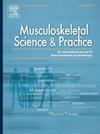认知肌肉疗法™治疗腰痛:一项试点研究。
IF 2.2
3区 医学
Q1 REHABILITATION
引用次数: 0
摘要
认知肌肉疗法™治疗慢性腰痛。背景:慢性腰痛(cLBP)是致残的主要原因。研究表明,患有cLBP的人过度激活腹部和浅表棘旁肌,这可能表明一种潜在的拮抗屈伸肌张力模式。本研究旨在测试一种新的cLBP干预措施,认知肌肉疗法™(CMT)。CMT将生物力学训练与疼痛管理的心理技术相结合,以改善体位张力。方法:CMT干预包括五个组成部分:理解背痛、全身放松、体位解构、情境触发和功能整合,并结合肌电(EMG)生物反馈来可视化竖脊肌活动。对15名cLBP患者进行了观察性病例系列研究,他们每个人每周接受7次CMT治疗。除了残疾和心理因素外,在行走过程中使用肌电图测量竖脊肌的激活谱。五名参与者通过访谈提供了定性反馈。结果:临床效果明显改善。罗兰-莫里斯残疾问卷得分降低7分,疼痛灾难化量表得分降低13.2分,运动恐惧症坦帕量表得分降低7.8分。肌电图数据显示,行走过程中竖脊肌的相位激活有所改善,而访谈显示自我效能增强,疼痛管理得到改善。结论:本研究首次采用CMT治疗cLBP,在减轻疼痛和残疾方面显示出良好的效果。通过在生物力学框架内整合心理策略,CMT提供了一种再训练肌肉活动的新方法。未来的工作现在需要探索所提出的作用机制,并充分量化这种新干预措施的临床有效性。试验注册:NCT05611476。本文章由计算机程序翻译,如有差异,请以英文原文为准。
Cognitive Muscular Therapy™ for low back pain: a pilot study
Cognitive Muscular Therapy™ for Chronic Low Back Pain.
Background
Chronic low back pain (cLBP) is a major cause of disability. Research shows that people with cLBP over activate the abdominal and superficial paraspinal muscles and this may indicate an underlying pattern of antagonistic flexor-extensor tone. This study was designed test a new intervention for cLBP, Cognitive Muscular Therapy™ (CMT). CMT integrates biomechanical training to improve postural tone with psychological techniques for pain management.
Methods
The CMT intervention included five components: Understanding back pain, General relaxation, Postural deconstruction, Contextual triggers, and Functional integration and incorporated Electromyography (EMG) biofeedback to visualise erector spinae activity. An observational case series was carried out on fifteen participants with cLBP, who each received seven weekly sessions of CMT. Alongside disability and psychological factors, the activation profile of the erector spinae was measured during walking, using EMG. Five participants provided qualitative feedback through interviews.
Results
Significant clinical improvements were observed. The Roland-Morris Disability Questionnaire score reduced by 7 points, the Pain catastrophizing scale reduced by 13.2 points and the Tampa scale of kinesiophobia reduced by 7.8 points. EMG data suggested improved phasic activation of the erector spinae during walking, while interviews showed increased self-efficacy and improved pain management.
Conclusion
This is the first study of CMT for cLBP, showing promising results in reducing pain and disability. By integrating psychological strategies within a biomechanical framework, CMT offers a novel approach to retraining muscle activity. Future work is now required to explore the proposed mechanism of action and fully quantify the clinical effectiveness of this new intervention.
Trial registration
NCT05611476.
求助全文
通过发布文献求助,成功后即可免费获取论文全文。
去求助
来源期刊

Musculoskeletal Science and Practice
Health Professions-Physical Therapy, Sports Therapy and Rehabilitation
CiteScore
4.10
自引率
8.70%
发文量
152
审稿时长
48 days
期刊介绍:
Musculoskeletal Science & Practice, international journal of musculoskeletal physiotherapy, is a peer-reviewed international journal (previously Manual Therapy), publishing high quality original research, review and Masterclass articles that contribute to improving the clinical understanding of appropriate care processes for musculoskeletal disorders. The journal publishes articles that influence or add to the body of evidence on diagnostic and therapeutic processes, patient centered care, guidelines for musculoskeletal therapeutics and theoretical models that support developments in assessment, diagnosis, clinical reasoning and interventions.
 求助内容:
求助内容: 应助结果提醒方式:
应助结果提醒方式:


